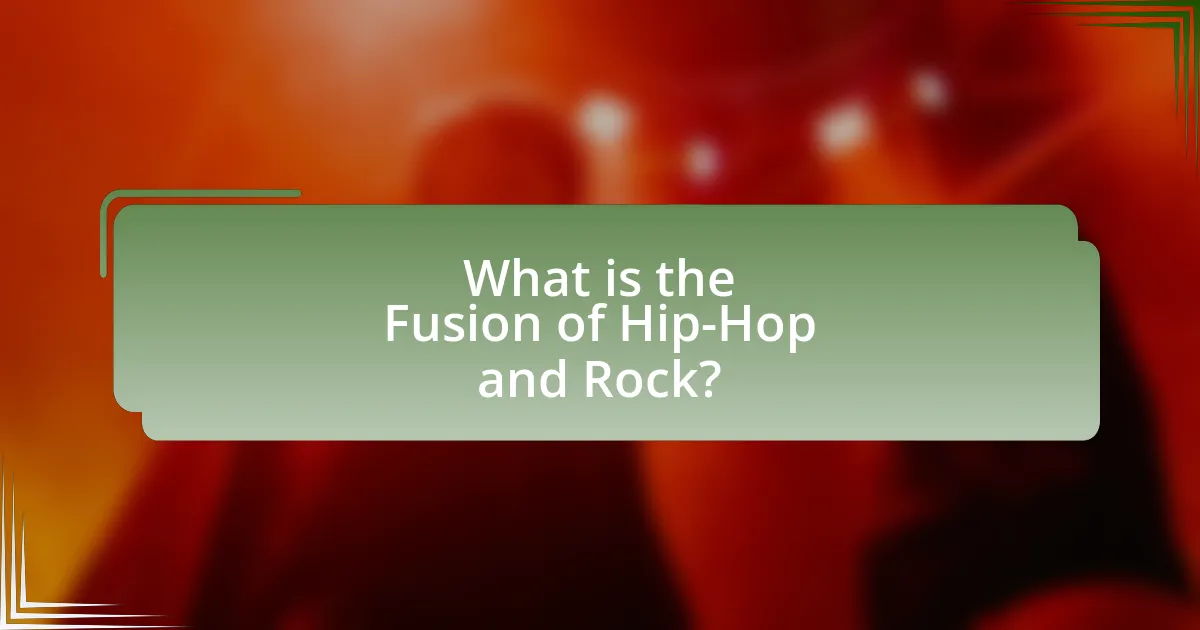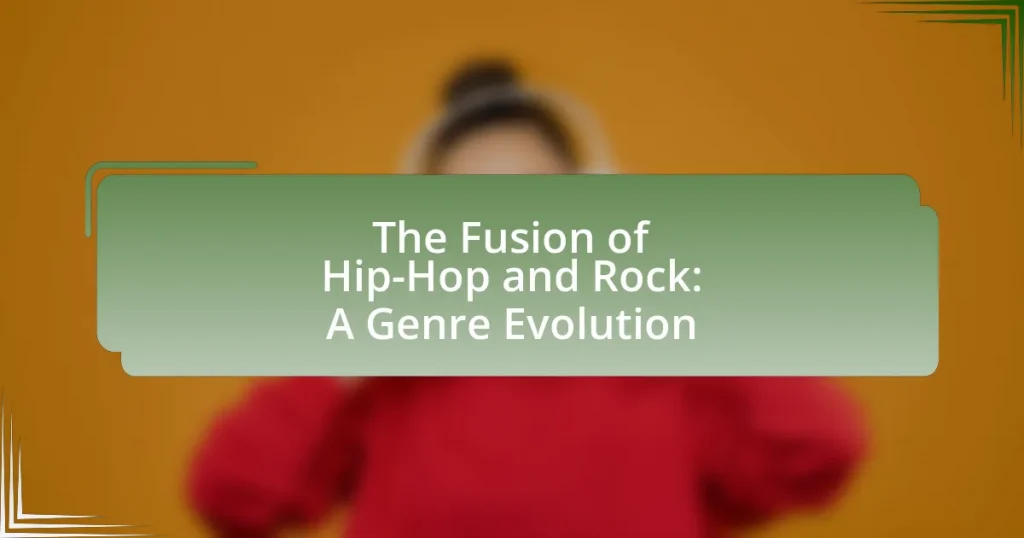The fusion of hip-hop and rock is a musical genre that combines the rhythmic vocal delivery of hip-hop with the instrumentation and energy of rock music. This genre emerged in the late 1980s and early 1990s, marked by collaborations such as Run-D.M.C. and Aerosmith’s “Walk This Way,” which bridged the gap between the two styles. The article explores the origins, historical influences, pioneering artists, defining characteristics, and cultural significance of this genre fusion, as well as the challenges and trends faced by contemporary artists. It highlights how this blend has reshaped musical landscapes and addressed social issues, while also examining the role of technology in its evolution.

What is the Fusion of Hip-Hop and Rock?
The fusion of hip-hop and rock is a musical genre that combines elements of both styles, characterized by the rhythmic vocal delivery of hip-hop and the instrumentation and energy of rock music. This genre emerged prominently in the late 1980s and early 1990s, with notable collaborations such as Run-D.M.C. and Aerosmith’s “Walk This Way,” which helped bridge the gap between the two genres. The fusion has since evolved, influencing various artists and leading to subgenres like rap-rock and nu-metal, with bands like Linkin Park and Rage Against the Machine exemplifying this blend. The successful integration of hip-hop beats, rapping, and rock instrumentation has created a dynamic sound that appeals to diverse audiences, showcasing the versatility and cultural significance of both genres.
How did the Fusion of Hip-Hop and Rock originate?
The fusion of Hip-Hop and Rock originated in the late 1970s and early 1980s as artists began to experiment with blending the rhythmic elements of Hip-Hop with the instrumentation and energy of Rock music. This genre crossover was exemplified by groups like Run-D.M.C., who collaborated with Aerosmith on the 1986 hit “Walk This Way,” effectively bridging the gap between the two genres and introducing Hip-Hop to a broader audience. The collaboration showcased how the aggressive beats and lyrical style of Hip-Hop could complement the guitar-driven sound of Rock, leading to a significant cultural and musical movement that influenced countless artists and genres thereafter.
What historical events contributed to the emergence of this genre fusion?
The emergence of the fusion between hip-hop and rock was significantly influenced by the cultural and social movements of the late 20th century, particularly the rise of hip-hop in the 1970s and the punk rock movement. The hip-hop genre began in the Bronx, New York, as a response to urban struggles, while punk rock emerged as a rebellion against mainstream music in the 1970s, characterized by its raw energy and anti-establishment themes.
Key events include the 1986 release of Run-D.M.C.’s collaboration with Aerosmith on “Walk This Way,” which bridged the gap between the two genres and brought hip-hop into the mainstream rock audience. Additionally, the 1990s saw further collaborations, such as those by Rage Against the Machine and Linkin Park, which solidified the genre fusion and reflected the socio-political climate of the time, including issues of race, class, and identity. These historical events collectively contributed to the evolution of a genre that blended the rhythmic elements of hip-hop with the instrumentation and attitude of rock music.
Who were the pioneering artists in the Fusion of Hip-Hop and Rock?
The pioneering artists in the fusion of Hip-Hop and Rock include Run-D.M.C., Beastie Boys, and Linkin Park. Run-D.M.C. is credited with popularizing the genre blend in the 1980s, particularly with their collaboration on the Aerosmith track “Walk This Way,” which became a significant crossover hit. The Beastie Boys further pushed the boundaries in the late 1980s and early 1990s with their album “Licensed to Ill,” which combined rap with rock elements. Linkin Park emerged in the early 2000s, successfully merging nu-metal with hip-hop influences, exemplified in their debut album “Hybrid Theory,” which sold over 10 million copies in the U.S. alone. These artists played crucial roles in establishing and evolving the fusion of Hip-Hop and Rock.
What are the defining characteristics of the Fusion of Hip-Hop and Rock?
The defining characteristics of the fusion of hip-hop and rock include the blending of rhythmic vocal delivery with guitar-driven instrumentation. This genre combines the lyrical storytelling and beats of hip-hop with the aggressive sound and musicality of rock, often featuring live instruments alongside samples and electronic beats. Notable examples include collaborations like Run-D.M.C. and Aerosmith’s “Walk This Way,” which exemplified this crossover in the 1980s, showcasing how both genres can enhance each other through shared themes of rebellion and social commentary. The fusion has evolved to include various sub-genres, such as rap-rock and nu-metal, further solidifying its place in contemporary music culture.
How do musical elements from both genres blend together?
Musical elements from hip-hop and rock blend together through the integration of rhythmic beats, lyrical storytelling, and instrumental layering. Hip-hop often utilizes strong, syncopated rhythms and samples from rock tracks, while rock incorporates rap verses and hip-hop beats, creating a hybrid sound. For example, collaborations like Run-D.M.C. and Aerosmith’s “Walk This Way” exemplify this fusion, where rock guitar riffs complement hip-hop rhythms, demonstrating how both genres can enhance each other’s musicality. This blending has led to a broader appeal and innovation within both genres, as seen in the works of artists like Kid Rock and Linkin Park, who seamlessly merge these elements in their music.
What lyrical themes are commonly explored in this fusion?
Lyrical themes commonly explored in the fusion of hip-hop and rock include rebellion, social justice, personal struggle, and identity. This genre often reflects the artists’ experiences and perspectives on societal issues, such as inequality and systemic oppression, which are prevalent in both hip-hop and rock music. For instance, songs like “Walk This Way” by Run-D.M.C. and Aerosmith address themes of cultural crossover and collaboration, while tracks like “Killing in the Name” by Rage Against the Machine highlight resistance against authority and injustice. These themes resonate with audiences, making the fusion a powerful medium for expression and commentary.
Why is the Fusion of Hip-Hop and Rock significant in music history?
The fusion of hip-hop and rock is significant in music history because it represents a groundbreaking collaboration that reshaped musical genres and cultural expressions. This fusion emerged prominently in the late 1980s and early 1990s, with artists like Run-D.M.C. collaborating with Aerosmith on “Walk This Way,” which became a pivotal moment that bridged the gap between the two genres. The blending of hip-hop’s rhythmic vocal delivery and rock’s instrumental intensity not only expanded the audience for both genres but also influenced the development of subgenres like nu-metal and rap-rock. This cross-pollination has led to a lasting impact on popular music, as seen in the works of bands like Linkin Park and artists like Kid Rock, who successfully integrated elements from both styles, further solidifying the significance of this fusion in the evolution of contemporary music.
What cultural impacts has this genre fusion had on society?
The fusion of hip-hop and rock has significantly impacted society by promoting cultural diversity and challenging social norms. This genre blending has led to the emergence of new musical styles, such as rap-rock and nu-metal, which have attracted diverse audiences and fostered cross-cultural collaborations. For instance, the collaboration between Aerosmith and Run-D.M.C. on “Walk This Way” in 1986 not only revitalized Aerosmith’s career but also brought hip-hop into mainstream rock culture, illustrating the genre’s ability to bridge gaps between different musical communities. Additionally, this fusion has served as a platform for addressing social issues, with artists using their music to comment on topics like race, inequality, and identity, thereby influencing public discourse and cultural perceptions.
How has the Fusion of Hip-Hop and Rock influenced other music genres?
The fusion of Hip-Hop and Rock has significantly influenced other music genres by introducing rhythmic complexity and lyrical depth, which have been adopted by genres such as pop, electronic, and alternative music. This blending has led to the emergence of subgenres like rap-rock and nu-metal, where artists like Linkin Park and Rage Against the Machine have successfully integrated rap verses with rock instrumentation. Additionally, the collaboration between artists from both genres, exemplified by tracks like “Walk This Way” by Run-D.M.C. and Aerosmith, has paved the way for cross-genre collaborations, encouraging artists in pop and electronic music to incorporate elements of both Hip-Hop and Rock into their work. This influence is evident in the mainstream success of artists like Post Malone and Lil Nas X, who blend genres to create innovative sounds that resonate across diverse audiences.
What challenges has the Fusion of Hip-Hop and Rock faced?
The fusion of Hip-Hop and Rock has faced significant challenges, primarily stemming from genre stereotypes and cultural differences. These challenges include resistance from purists of both genres who often view the blending as a dilution of their respective musical identities. For instance, traditional rock fans may criticize Hip-Hop’s rhythmic and lyrical style, while Hip-Hop enthusiasts might reject the perceived elitism of rock music. Additionally, commercial viability poses a challenge, as record labels may hesitate to invest in hybrid projects due to uncertain market reception. Historical examples include the mixed reception of collaborations like Aerosmith and Run-D.M.C.’s “Walk This Way,” which, despite its success, faced backlash from fans of both genres.
How have critics responded to this genre fusion over the years?
Critics have responded to the fusion of hip-hop and rock with a mix of enthusiasm and skepticism over the years. Initially, the collaboration was met with excitement, as seen in the 1980s when artists like Run-D.M.C. and Aerosmith released “Walk This Way,” which was praised for bridging cultural divides and expanding musical boundaries. However, as the genre evolved, some critics expressed concerns about authenticity and commercialization, particularly in the 2000s when mainstream artists like Linkin Park and Jay-Z collaborated. Critics argued that these partnerships sometimes diluted the essence of both genres. Despite this, many acknowledged the innovative nature of the fusion, highlighting its role in shaping contemporary music and influencing new artists. Overall, the critical response has been varied, reflecting both appreciation for creativity and caution regarding artistic integrity.
What barriers have artists encountered in creating this fusion?
Artists have encountered several barriers in creating the fusion of hip-hop and rock, primarily including genre stereotypes, cultural appropriation concerns, and industry resistance. Genre stereotypes often lead to preconceived notions about the authenticity of artists who blend these styles, making it difficult for them to gain acceptance from purists of either genre. Cultural appropriation concerns arise when artists from one genre adopt elements from another, leading to accusations of exploitation rather than genuine collaboration. Additionally, industry resistance manifests in challenges related to marketing and promotion, as record labels may be hesitant to invest in projects that do not fit traditional genre categories, limiting opportunities for artists to showcase their work. These barriers collectively hinder the creative process and the commercial viability of fusion projects.
What are the current trends in the Fusion of Hip-Hop and Rock?
Current trends in the fusion of Hip-Hop and Rock include the increasing collaboration between artists from both genres, the blending of musical elements, and the rise of genre-bending subgenres. Collaborations such as those between Lil Nas X and rock artists, or Machine Gun Kelly’s transition to pop-punk, illustrate this trend. Additionally, the incorporation of rock instrumentation, like electric guitars and live drums, into Hip-Hop tracks is becoming more prevalent, as seen in songs by artists like Post Malone and Travis Scott. This fusion is further supported by streaming platforms that promote genre-blending playlists, reflecting a growing audience interest in diverse musical styles.
How are contemporary artists redefining this genre fusion?
Contemporary artists are redefining the fusion of hip-hop and rock by incorporating diverse musical elements and innovative production techniques. For instance, artists like Lil Nas X and Machine Gun Kelly blend traditional rock instrumentation with hip-hop rhythms and lyrical styles, creating a hybrid sound that appeals to a broad audience. This genre evolution is evidenced by the commercial success of tracks like “Old Town Road,” which topped charts across multiple genres, demonstrating the growing acceptance and popularity of this fusion. Additionally, collaborations between artists from both genres, such as Travis Barker’s work with various hip-hop artists, further exemplify how contemporary musicians are pushing the boundaries of genre classification and expanding the sonic landscape.
What role does technology play in the evolution of this fusion?
Technology plays a crucial role in the evolution of the fusion between hip-hop and rock by enabling innovative sound production and distribution methods. The advent of digital audio workstations (DAWs) and software synthesizers has allowed artists to blend genres seamlessly, creating unique sounds that were previously unattainable. For instance, the use of sampling technology has been pivotal, as artists like Linkin Park and Jay-Z have utilized samples from rock tracks to create hybrid songs that appeal to diverse audiences. Additionally, platforms like SoundCloud and YouTube have democratized music distribution, allowing emerging artists to share their fusion creations widely, thus accelerating the genre’s evolution and popularity.
How can artists successfully create music that fuses Hip-Hop and Rock?
Artists can successfully create music that fuses Hip-Hop and Rock by blending rhythmic vocal delivery with guitar-driven instrumentation. This fusion can be achieved through collaboration between artists from both genres, allowing for the incorporation of Hip-Hop beats and lyrical styles alongside Rock’s melodic and harmonic elements. Historical examples, such as the collaboration between Run-D.M.C. and Aerosmith on “Walk This Way,” demonstrate the commercial viability and cultural impact of this genre fusion, leading to a broader acceptance and innovation within both musical styles. Additionally, artists can experiment with production techniques, such as sampling Rock tracks or using live instrumentation in Hip-Hop beats, to create a unique sound that resonates with fans of both genres.
What best practices should artists follow when blending these genres?
Artists should prioritize authenticity and respect for both genres when blending hip-hop and rock. Authenticity ensures that the fusion resonates with audiences familiar with the roots of each genre, while respect involves understanding the cultural significance and historical context of both hip-hop and rock. For instance, successful collaborations, such as those between Run-D.M.C. and Aerosmith, demonstrate how artists can honor the essence of each genre while creating something innovative. Additionally, artists should experiment with instrumentation and lyrical themes that reflect the strengths of both styles, as seen in the works of Linkin Park, which effectively combined rock instrumentation with hip-hop rhythms and vocal styles. This approach not only broadens the appeal but also enriches the musical landscape, allowing for a more dynamic and engaging listening experience.
What common pitfalls should artists avoid in this genre fusion?
Artists should avoid losing their unique identity when fusing hip-hop and rock genres. This pitfall often occurs when artists overly conform to the expectations of either genre, resulting in a diluted sound that lacks authenticity. For instance, many artists who attempt genre fusion may prioritize commercial appeal over artistic expression, leading to a product that feels inauthentic to both hip-hop and rock audiences. Additionally, neglecting the cultural roots and historical context of each genre can alienate fans and diminish the impact of the fusion. Successful genre fusion requires a careful balance of elements from both styles while maintaining the artist’s distinct voice and vision.




